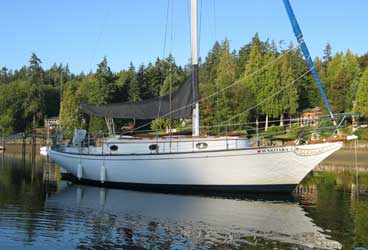
Ericson 31
Designed by Bruce King for Ericson Yachts, the Ericson Cruising 31 was the first edition of a traditional-looking design that evolved into the Independence 31. In all, about 70 of these boats were produced between 1977 and 1982.
The majority of Cruising 31s are sloop rigged and have fixed cat’s-eye portlights. The Independence boats are cutters and have rectangular opening ports and a different accommodation plan. Below the waterline, both boats have a cutaway keel encapsulating 4,500 pounds of lead ballast and a skeg-and-transom-hung rudder.
The Cruising 31 carries a masthead rig. I often sail mine singlehanded with the 210-square-foot mainsail doused. A 130-percent roller-furling genoa alone will drive the boat well. Tucking a deep reef in the main and/or rolling in some of the headsail brings the boat up to manageable angles of heel in winds over 20 knots. This is a stiff and well-balanced boat; it tracks well and is quick to tack, though it’s unpredictable when backing under power.
Topside, the Cruising 31 has ample side decks and handrails for safe movement forward and aft. An 8-foot tender will fit forward of the mast. The original single-speed Barlow 20 sheet winches would be considered inadequate today, but many boats soldier on with them. Some owners have fitted an anchor sprit with a windlass and larger bow rollers to ease the anxiety of working on the narrow foredeck.
The cockpit is large, and the seats are deep. Tiller steering was standard, but most owners opted for wheel steering, which rather divides the cockpit in two. Storage is restricted to beneath the port seat hatch, which also gives access to the batteries and other mechanical and electrical equipment.
Ericson originally powered the boats with a two-cylinder Westerbeke Pilot 20, but a variety of engines followed.
Belowdecks, the Ericson Cruising 31 has a small chain locker in the forepeak, just forward of a double berth that’s short and pinched. A large head with a sink and considerable storage is just aft to starboard, and a hanging locker and shelf are to port. The saloon table has a folding leaf and hinges to the main bulkhead. Settee berths to port and starboard have ample storage behind them and beneath the foam cushions. The starboard seat slides out to provide a narrow double berth when the table is lifted.
The L-shaped galley has a sink, stove, and icebox and offers convenient dish and cutlery storage. A 45-gallon freshwater tank is located below the sole aft of the sink. On some boats, a clever chart table drops down over the starboard quarter berth.
Other than the usual caveats about older boats, the Ericson Cruising 31 has few structural issues. Many owners, myself included, have experienced “rudder clunk,” which occurs when the bronze pintle at the base of the rudder wears against the bronze gudgeon—it drives you nuts at anchor. An easy fix is to wrap a strip of sheet Teflon around the pintle before easing it back into the gudgeon.
The Ericson Cruising 31 is a wholesome compromise with a traditional hull and a 1970s sail plan and underbody. It stands up to heavy weather with a minimum of fuss and will ghost along surprisingly well in lighter air. Asking prices vary widely, from about $30,000 to $50,000.
Ericson Cruising 31
LOA 30′ 11″ (9.42 m.)
LWL 23′ 11″ (7.29 m.)
Beam 10′ 5″ (3.18 m.)
Draft 4′ 11″ (1.50 m.)
Sail Area (100%) 458 sq. ft. (42.5 sq. m.)
Ballast 4,500 lb. (2,041 kg.)
Displacement 11,400 lb. (5,170 kg.)
Ballast/D .39
D/L 372
SA/D 14.5
Water 45 gal. (171 l.)
Fuel 35 gal. (133 l.)
Engine Westerbeke Pilot 20
Designer Bruce King
Richard Smith and his wife, Beth, sail their Ericson Cruising 31, Kuma, in the Pacific Northwest.








